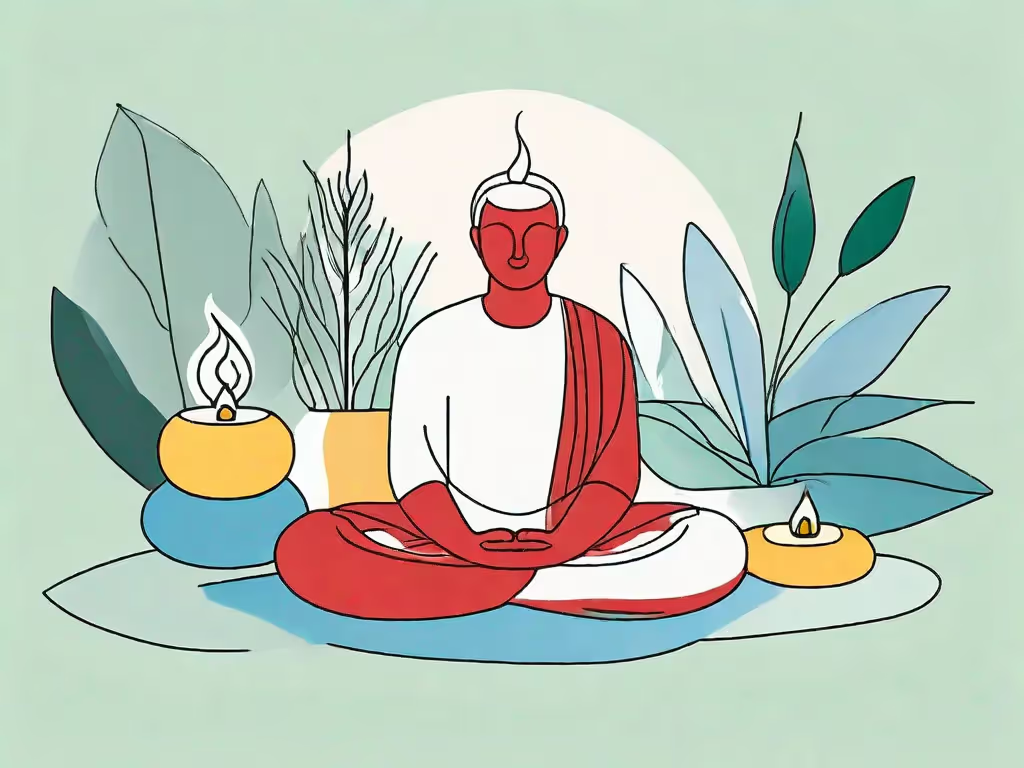Meditation is a practice that has been cherished for centuries, providing numerous benefits for both the body and mind. But did you know that the position you choose for your meditation practice can greatly impact its effectiveness? In this article, we will explore the best meditation positions for optimal practice, and discuss how they can elevate your meditation experience.
Understanding the Importance of Meditation Positions
Before we delve into specific meditation positions, let's take a moment to understand why they are important. The connection between the body and mind is undeniable, and finding a comfortable and stable position helps create a conducive environment for deep meditation. By adopting the right posture, you allow your body to relax, which, in turn, allows your mind to follow suit.
Meditation has been practiced for centuries as a means to achieve inner peace, clarity, and self-awareness. It is a practice that requires focus and discipline, and the position in which you meditate plays a crucial role in enhancing the overall experience. When your body is aligned and at ease, it becomes easier to quiet the mind and enter a state of deep relaxation.
The Connection Between Body and Mind
There is a profound connection between our physical body and our mental state. When we sit in an upright and balanced position, it sends a signal to our brain that we are calm and present. This alignment of the body not only helps to release tension but also promotes mental clarity and focus.
Imagine a tree with strong roots firmly planted in the ground. This stability allows the tree to withstand strong winds and external disturbances. Similarly, when we sit in a stable meditation position, we create a sense of grounding within ourselves. This grounding enables us to navigate the ups and downs of our thoughts and emotions with greater ease.
Furthermore, the connection between body and mind is reciprocal. Just as our physical posture affects our mental state, our mental state can also influence our physical well-being. When we are stressed or anxious, our bodies tend to tense up, leading to physical discomfort. By practicing meditation and adopting the right position, we can release this tension and promote a sense of calm and relaxation throughout our entire being.
How Positioning Affects Your Meditation Practice
The way you position your body during meditation can have a significant impact on the quality of your practice. For example, a slouched posture can lead to feelings of lethargy and a wandering mind, while excessive tension in the body can cause discomfort and distraction. By choosing the right meditation position, you can create an environment conducive to deep concentration and inner peace.
There are various meditation positions to choose from, each with its own benefits and considerations. The most common position is the cross-legged or lotus position, where you sit with your legs crossed and your spine straight. This position helps to align the body's energy centers and promotes a sense of stability and balance.
Another popular position is the kneeling position, where you sit on your knees with your buttocks resting on your heels. This position is particularly beneficial for individuals who find it challenging to sit cross-legged for an extended period. It allows for a straight spine and provides a sense of grounding.
Some practitioners prefer to meditate while sitting on a chair or using props such as cushions or meditation benches. These options can provide additional support and comfort, especially for those with physical limitations or injuries.
Regardless of the position you choose, it is essential to find a balance between relaxation and alertness. Your posture should be comfortable enough to sustain for an extended period, yet upright enough to keep you focused and attentive. Experiment with different positions and listen to your body to find the one that works best for you.
In conclusion, meditation positions are not merely about physical comfort but also about creating an optimal environment for deepening your meditation practice. By understanding the connection between body and mind and choosing the right position, you can enhance your ability to achieve inner stillness, clarity, and self-discovery.
Exploring Different Meditation Positions
Now that we understand the importance of meditation positions, let's explore some of the most common ones:
The Classic Lotus Position
The lotus position is a well-known meditation posture that involves crossing your legs and resting the feet on the opposite thighs. This position is often associated with a sense of groundedness and stability. However, it requires a certain level of flexibility and may not be suitable for everyone.
The Comfortable Seiza Position
For those who find the lotus position challenging, the seiza position is a great alternative. In this posture, you kneel with your legs tucked underneath you and rest your weight on a cushion or meditation bench. This position provides a stable foundation while keeping your spine aligned.
The Simple Chair Position
If sitting on the floor is uncomfortable for you, there is no shame in practicing meditation in a chair. The key is to choose a chair that allows your feet to rest flat on the ground, with your back straight and unsupported. This position is ideal for individuals with physical limitations or those who prefer a more relaxed approach to meditation.
The Lying Down Position
If you struggle with maintaining an upright posture due to physical discomfort, you can practice meditation while lying down. However, it's important to be mindful of not falling asleep. Lying down can create a sense of relaxation, but it may also make it challenging to stay fully present and alert.
Tips for Choosing the Right Meditation Position
Now that we have explored different meditation positions, let's discuss some tips to help you choose the right one for your practice:
Considering Your Physical Limitations
Before settling on a meditation position, it's crucial to take into account any physical limitations you may have. If you have knee or back issues, for example, sitting on the floor may not be advisable. In such cases, alternative positions like the seiza or chair position might be better suited to your needs.
Assessing Your Comfort Level
Comfort plays a significant role in sustaining a consistent meditation practice. Experiment with different positions to find the one that feels the most comfortable for you. Remember, there is no one-size-fits-all approach, and what works for others may not work for you. Listen to your body and make adjustments as needed.
Adapting Positions for Longer Sessions
For longer meditation sessions, it's important to choose a position that allows you to maintain comfort and stability for an extended period of time. It may be helpful to use props and cushions to support your body and alleviate any discomfort that may arise. Remember, the key is to find a balance between relaxation and alertness.
Common Mistakes in Meditation Posture
While it is important to know the right meditation positions, it is equally crucial to be aware of common mistakes that can hinder your practice:
Slouching and Misalignment
One common mistake is slouching or allowing your body to become misaligned during meditation. This not only affects your breathing but also leads to poor posture and discomfort. To avoid this, maintain a straight spine and adjust your position whenever you feel yourself slumping.
Excessive Tension in the Body
Tension in the body is another common pitfall. Consciously scan your body for any areas of tension and consciously release them. Relax your shoulders, soften your facial muscles, and allow your body to become fully at ease. By doing so, you create a space for deeper meditation.
Ignoring Discomfort and Pain
Ignoring discomfort or pain during meditation is a recipe for distraction and unease. Instead of pushing through discomfort, honor your body's signals and make the necessary adjustments. If sitting for extended periods becomes painful, consider switching to a more comfortable position like a chair or lying down.
In conclusion, finding the right meditation position is crucial for optimizing your practice. By understanding the importance of body-mind connection and exploring different positions, you can create a comfortable and stable foundation for deep meditation. Remember to listen to your body, adapt positions to your needs, and be mindful of common mistakes that can hinder your progress. With the right position, you can unlock the full potential of your meditation practice and enhance your well-being.
Aura is Your All In One App for Meditation, Mindfulness Wellbeing
Find peace every day with one app for your whole well-being. There is no one-size-fits-all solution to mental well-being. Aura is the first all-in-one wellness app that learns how to best help you. Discover an endless library of expert-created tracks for your well-being, all taught by the world’s best coaches, therapists, and storytellers. With Aura's personalized recommendations, you can find peace every morning, day and night.



.webp)






.avif)

%20(1).avif)


.avif)
.avif)
.webp)


.avif)


















































































































.avif)

















.svg)









